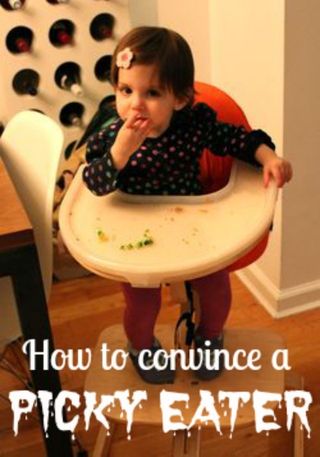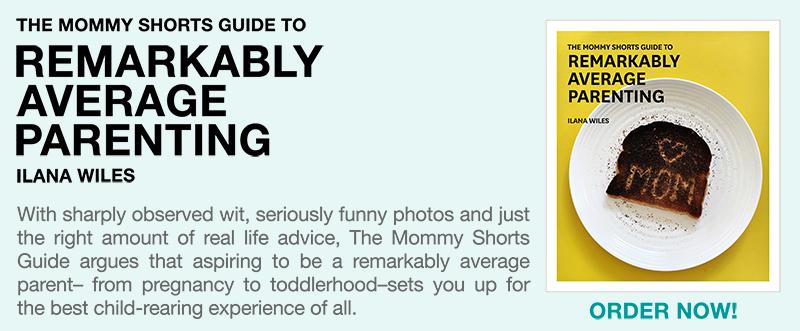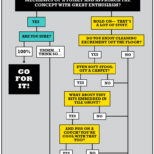
Mazzy used to be a pretty good eater. She would eat a variety of healthy foods including avocado, tomatoes and broccoli. Chicken was a harder sell but with the right preparation (Chicken Tikka Masala from an Indian place on 6th Street), she'd humor us with a bite or two.
But as Mazzy has gotten older (she is a whooping 15 months now), she's started to notice all the tasty little snacks that Mike and I shove in our mouths between meals when we think she isn't looking. Pretzels, crackers, Twizzlers, chips and the mother of all things I cannot live without— ice cream.
Well. Mazzy wants in. And on occasion, we oblige. (If you like, you can click here to read all about our stand-off over a doughnut.)
To make matters worse, Mazzy has now learned the words for both pretzel and cracker. She screams them over and over again the second we sit her down in the highchair and present anything resembling a well-balanced meal.
It is a problem.
So, I did what any mother who has exclusive access to a developmental psychologist would do— I enlisted professional help.
Dear Dr. B,
I have three questions: 1) How do I encourage healthy eating in a 15 month old? 2) How do I communicate that certain foods are okay sometimes but that she can't have them whenever she wants? And 3) FOR THE LOVE OF BROCCOLI, HOW DO I STOP THE BEGGING?
Signed,
Mommy Shorts
Dear Mommy Shorts,
Picky eating is very common among young children and they often get stuck on specific preferred foods for brief periods of time. Usually these preferences are temporary but if they are stuck on unhealthy choices or an unbalanced diet, it is a good idea to intervene.
Below are some tips for encouraging healthy eating behavior:
Provide Healthy Choices: Limit your child’s diet to only healthy options but provide lots of choices. Select healthier snacks between meals that would be acceptable during mealtimes as well. If they ask for something that is not on the plate, say, “we don’t have pretzels” in a neutral tone and then present the choices they do have in a positive way. (Editor's Note: I guess it would be a good idea not to store pretzels and crackers in an exposed snack bowl on the kitchen counter— damn NYC kitchen cabinet space!)
Children develop preferences very early and they cannot develop preferences for junk food if it is not available. If possible, it is best to introduce unhealthy snacks when children are old enough to understand that these items are only for special times or occasions.
Positive Attention for Good Eating, Ignore Other Behaviors: The most common strategy suggested for picky eating in young children is to give positive attention when your child exhibits good eating behaviors (e.g., exploring, touching, or tasting the healthy food presented) and ignoring your child’s whining or begging for the other food after you have already indicated that it is not available. This does not mean that you should ignore your child entirely. You should just ignore the begging while you continue to encourage them to eat the food offered.
In order for this strategy to work, you need to remain consistent, calm and positive. Do not give in, which will reward and increase the whining and screaming behavior. Try to reduce any tension this may cause by providing tons of positive attention to serve as a distraction.
Keep in mind that it is important not to force your child into eating the healthy item because then eating will become associated with negative feelings and discomfort.
Be a Good Model: Another strategy that often works is trying the food yourself. Sometimes a simple, “Ummm, yummy, tastes like crackers!” does the trick. Usually when you are willing to try the food and show your child how good it tastes, they are willing to try it too.
Consider Likes and Dislikes: Some children have preferences for different tastes or textures. Your child may like pretzels because they are crunchy or salty. Find healthy options with similar taste profiles. Many children love ketchup and they are willing to eat anything as long as it has a little ketchup on it.
Be Creative and Make Mealtime Fun: Consider your child’s interests and think about what may make healthy food look fun and exciting for them. For example, if they love a specific animal or character, buy a special plate or spoon with the character on it. Cut foods into interesting shapes or present them on the plate in an interesting way. For example, you can cut fruits and vegetables into fun shapes and then put them in various containers so that they always look like an exciting new snack.
Adjust Portion Size but Don’t Stop Serving: Children may be more willing to try a small piece of something new but may be unwilling to try anything when a whole plate of it is presented. Continue to present new foods but in small amounts. It can take 10 to 15 times before a child tries a new food so it is important to be patient. If you continue to serve it, they will eventually try it.
Combine Likes and Dislikes: Sometimes the best strategy is to combine healthy foods with preferred foods so that eating continues to be a positive experience for everyone. Spread avocado on top of a small cracker or crush a few pretzels in the pasta bowl. When your child requests the snack item, only present it with healthier items. Be stingy with the snack but very generous with the healthy items. When they are finished with the preferred snack, be firm that there is none left. If your child is hungry, they will eventually eat the healthier food to satisfy their hunger.
The good news is that children are generally not stubborn enough to go hungry. Don’t be concerned if they skip a meal at first, they will not starve. Instead they will learn to be more flexible eaters.
Obviously the easiest path to healthy eating is to only present healthy options right from the beginning. But birthday parties, play dates, road trips, etc. tend to make controlling the food your child is exposed to much more of a challenge. Hopefully, these tips can steer you back in the right direction.
—Dr. B
If you have a question for Dr. B, our resident developmental psychologist, please email me at myshort@mommyshorts.com.

























How does one get exclusive access to a developmental psychologist? I’m, um… just curious…
One spends the entirety of their life dealing with the same set of parents.
(She is my sister.)
My little one demands crackers every night before bed. I try to tell her no and offer other snacks but the screaming doesn’t stop until I cave. I have been trying to offer healthier choices to her during the day but they usually end up on the floor or directly in the dogs’ mouthes. Maybe one day she will actually eat them.
I always found that part of toddlerhood is them exercising their opinions. So many kids I know started off as good eaters, got picky during their toddler year(s) and then went back to eating well.
I need to forward this to the Daddy! He gets sooooo frustrated by the kid whining for food. Of course, I try to tell him if the kid is whining for fruit, it could be SOO much worse!
Sussman wasn’t in the least bit concerned about it. He thought they could eat vegetables when they grew up. Of course, he kept a pastrami sandwich in his fridge in the office and smelled from cigars.
Also possible that lack of nutrients as a child is what stunted his growth.
I am convinced fruit was put on this earth to give moms a break. Healthy, sweet and child-requested.
I am going to play the part of dr. B here and say— NEVER CAVE!
(I know, easier said then done.)
Good to know. But I was also told, if they don’t like vegetables now, good luck getting them to eat it later.
Maybe you should try sneaking the healthy snacks & foods so that Mazzy will think those are the ones to crave. “Here comes the airplane” works for a while. Now you know why I didn’t keep that junk around when you were a tiny tot.
Why not add something she doesn’t like on the cracker like chopped liver. She may never ask for a cracker again.
Reverse psychology. I like it! And don’t think that I didn’t stuff my face with ring dings and doritos at friends’ houses, mom:)
Here have been our strategies, yielding us a 6 year old who is “pretty good” about food (fave foods include Lebanese meat and lamb pies, feta cheese, guac and black beans – but he still won’t tolerate a sauce on top of anything and could happily live on frozen multigrain waffles) and a picky (but not insanely picky) 3 year old.
1) We have a snack drawer. (This could be a basket or something.) Anything from the snack drawer is acceptable at any time, and they can access it. It only contains teeny boxes of raisins, whole grain crackers, other dried fruit, maybe a few tiny bags of airplane pretzels and squeezy apple-carrot sauce, but there is something about knowing they can choose.
2) Fruit is always an option. Both of my kids say this to us, unprompted. Who cares if they have 2 pears and no noodles?
3) Get snacky. My kids find anything in tapas form better, including cheese cut in little squares, small quiches, etc.
4) As they get older, we try to have veggies and low-fat ranch dressing ready when they come home (while I am frantically getting dinner together) so that they snack on that. That way, they may ingest some veggies prior to the meal, meaning I am more laid back about broccoli consumption. (Also – my kids love the frozen cheesy broccoli rice – who wouldn’t – so I buy it.)
And seriously, who doesn’t cave? The whining will eventually put me into a home.
I am having same problem with my kid right now. I sure do hope this article helps me out. I am not giving up I will keep on trying to offer him healthy foods until he does take it.
Your blog is really awesome, that is why I just keep on coming back. It will be my pleasure if you visit mine @ http://www.zuup.com/what-is-zuup You see I’m a health care enthusiast, looking forward to hearing from you.
You got a very nice blog, Here check this out, http://www.zuup.com/blog/index.php/healthy-brain-for-you/ We both share the same passion, health and health news. Have a Nice Day!
Great post. I was checking constantly this blog and I
am inspired! Extremely helpful info specially the remaining section 🙂 I maintain such info a
lot. I was looking for this certain info for a long time.
Thank you and good luck.
It’s the best time to make a few plans for the future and it’s time
to be happy. I’ve read this publish and if I may just I desire to counsel you some interesting issues or suggestions.
Perhaps you could write subsequent articles referring
to this article. I desire to read even more things about it!
This article provides clear idea designed for the new visitors of blogging, that truly how to do running a blog.
Hi there! I could have sworn I’ve been to your blog before
but after going through many of the articles I realized it’s new to
me. Anyways, I’m certainly delighted I stumbled upon it and I’ll
be book-marking it and checking back frequently!
Wow, that’s what I was exploring for, what a stuff!
existing here at this website, thanks admin of this website.
To save the battery Google Nexus One offers a new innovation: with just one click all wireless connections (after all they kill your battery) are switched off.
This simple freeware application works pretty well,
given how basic the interface is. Using this technique means removing an object from its original background.
Wonderful site you have here but I was curious if
you knew of any message boards that cover the same topics discussed
in this article? I’d really like to be a part of community where I can get feed-back from other experienced people
that share the same interest. If you have any suggestions,
please let me know. Bless you!
It’s a shame you don’t have a donate button! I’d definitely donate to this outstanding blog!
I suppose for now i’ll settle for book-marking and adding your RSS feed to my Google account.
I look forward to fresh updates and will talk about this blog with my Facebook group.
Chat soon!
What’s up to every body, it’s my first go to see of this blog; this blog consists
of amazing and genuinely fine data for readers.
Hello everyone, it’s my first pay a visit at this site, and post is actually fruitful in support of me,
keep up posting such content.
I tend not to leave many responses, however
after reading through a few of the responses here How To Convince
A Picky Eater To Eat Something Other Than A Cracker –
Mommy Shorts. I do have 2 questions for you if it’s okay.
Is it just me or do some of these responses come across like they are coming from brain dead people?
😛 And, if you are posting on other places, I’d like to keep up with everything new you have to post.
Could you list of the complete urls of your public sites like your twitter
feed, Facebook page or linkedin profile?
I am now not positive the place you’re getting your info,
however great topic. I must spend some time finding out more or
working out more. Thanks for excellent information I used to
be searching for this info for my mission.
Fantastic web site. A lot of helpful info here. I am sending it to some
buddies ans also sharing in delicious. And naturally, thank you
to your sweat!
An interesting discussion is worth comment. I believe that you ought
to write more about this subject, it might not
be a taboo subject but usually folks don’t discuss these subjects.
To the next! All the best!!
Thank you for the good writeup. It in reality was a leisure account it.
Glance complicated to more introduced agreeable from you!
However, how can we keep in touch?
Nice respond in return of this matter with solid arguments and
telling all on the topic of that.
There’s certainly a lot to know about this issue. I like all the points you’ve made.
Hurrah! Finally I got a weblog from where I can in fact get
useful facts regarding my study and knowledge.
I comment each time I appreciate a post on a site or I have something to add to the discussion. Usually it’s
caused by the sincerness communicated in the post I browsed.
And on this article How To Convince A Picky Eater To Eat
Something Other Than A Cracker – Mommy Shorts. I was actually excited enough to post a comment 🙂 I do have some questions for
you if it’s okay. Is it just me or does it seem like
some of these comments look like they are left by brain dead folks?
😛 And, if you are writing at additional social sites, I’d like to follow anything fresh you have to post.
Could you make a list every one of all your communal pages like your Facebook page,
twitter feed, or linkedin profile?
Having read this I thought it was rather informative.
I appreciate you taking the time and effort to put this informative
article together. I once again find myself spending a lot of time
both reading and commenting. But so what, it was still worthwhile!
I read this article completely regarding the comparison of latest and previous technologies, it’s awesome article.
Very rapidly this website will be famous amid all blogging and site-building viewers, due to it’s good
articles
Excellent post. I was checking continuously this blog and I’m inspired!
Extremely useful info specifically the final part 🙂 I take care of such information a lot.
I used to be looking for this certain information for a very lengthy time.
Thank you and good luck.
Hi everyone, it’s my first visit at this
website, and paragraph is actually fruitful for me, keep up posting these types of content.
That is a good tip especially to those new to the blogosphere.
Short but very accurate information… Many thanks for sharing
this one. A must read article!
Everything is very open with a precise clarification of the issues.
It was truly informative. Your site is very useful.
Thank you for sharing!
Oh my goodness! Incredible article dude! Thanks, However I am encountering difficulties with your RSS.
I don’t understand the reason why I cannot join it.
Is there anybody getting identical RSS issues? Anybody who
knows the solution can you kindly respond? Thanx!!
Thanks for finally writing about >How To Convince
A Picky Eater To Eat Something Other Than A Cracker – Mommy Shorts <Loved it!
I got this web site from my pal who told me concerning this
web page and now this time I am visiting this website and reading very
informative articles at this time.
Everything is very open with a clear clarification of the challenges.
It was really informative. Your website is extremely
helpful. Thank you for sharing!
Unquestionably consider that which you stated. Your favourite justification appeared to be at the net the easiest thing to keep
in mind of. I say to you, I certainly get annoyed whilst other folks think about worries that they plainly do not know about.
You controlled to hit the nail upon the top and outlined out the whole
thing with no need side effect , other folks could take a signal.
Will probably be back to get more. Thanks
Its not my first time to visit this web site, i am browsing
this web site dailly and take pleasant information from here
all the time.
My brother suggested I may like this web site. He was totally right.
This put up truly made my day. You can not consider simply how
much time I had spent for this information! Thank you!
Having read this I thought it was rather informative.
I appreciate you spending some time and energy
to put this content together. I once again find myself spending a significant amount of time
both reading and posting comments. But so what, it was still worth it!
Good post. I certainly appreciate this website. Stick with it!
If you would like to get a good deal from this piece of writing
then you have to apply such strategies to your won blog.
I would like to convey firts,…… This can make us more pretty options here.
I definitely enjoying every little bit of it. This is a great website and good share. I want to thank you. very nice! You guys make a great blog, and have some great content. Keep up the good work.
Enjoy genuine female escorts service in Delhi at reasonable price.
I like this article, and hope to read more such articles, for the goa escorts service you can also visit through this website, you can call goa escorts Service This is Goa’s best and trusted website.
I think this is a very helpful article, all the readers must read the articles to all readers. And these free classifieds website will also be of use to you, you will also visit them as well. https://freeprachar.com
Are you looking for the best Escorts services company based in Delhi? You will get adorable escort services such as Independent Call Girls, Delhi Call Girl Service, college girls in Delhi, and Pune Escorts Services. For more information call us at 7428480268.
gaurang enterprise
Melt Ur Heart With Delhi Pleasure Girl Megha Malik
I am ready to fulfil you on the bed as you have never enjoyed in life.
I am ready to fulfil you on the bed as you have never enjoyed in life. You will feel hot and sensual with me. Baby!!
I can make you feel fantastic. I assure you romance, pleasure and seduction. I will make your desires come true. Pick me for fun at very low rates.
I always say “See me once and you’ll understand”!
Indulge with me and I promise you’ll understand after we’ve met!